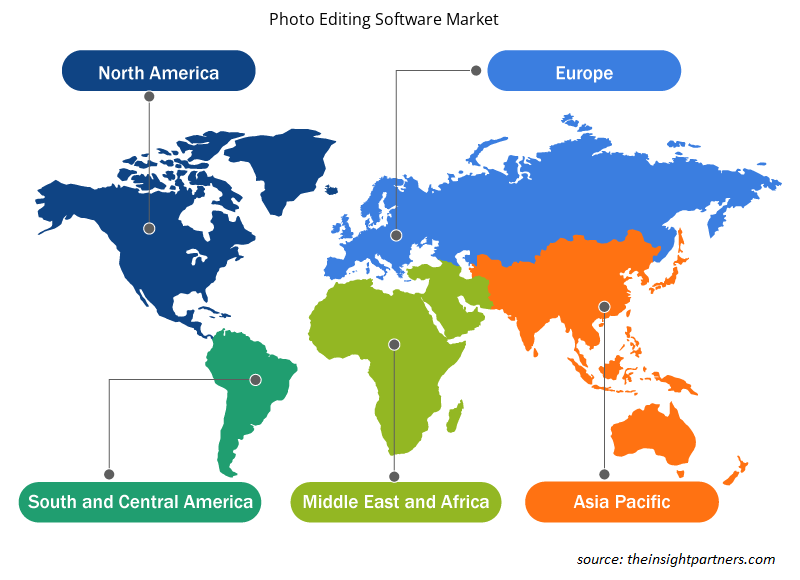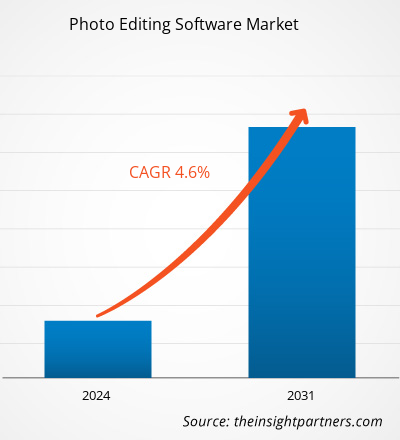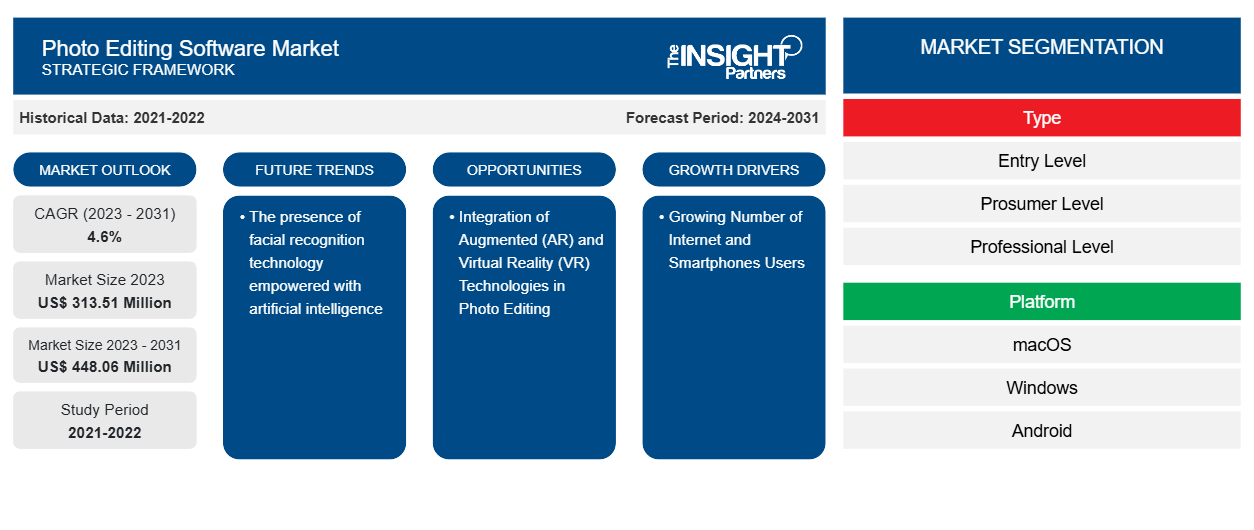من المتوقع أن يصل حجم سوق برامج تحرير الصور إلى 448.06 مليون دولار أمريكي بحلول عام 2031 من 313.51 مليون دولار أمريكي في عام 2023. ومن المتوقع أن يسجل السوق معدل نمو سنوي مركب بنسبة 4.6٪ في الفترة 2023-2031. ومن المرجح أن يظل وجود تقنية التعرف على الوجه المدعومة بالذكاء الاصطناعي أحد الاتجاهات الرئيسية في سوق برامج تحرير الصور.
تحليل سوق برامج تحرير الصور
ينمو سوق برامج تحرير الصور بوتيرة سريعة بسبب العدد المتزايد من مستخدمي الإنترنت والهواتف الذكية والطلب المتزايد على الصور الرقمية بين المستهلكين. يتوسع السوق بشكل مطرد، مدفوعًا بالحاجة المتزايدة إلى صور عالية الجودة من الاستخدامات الفردية والتجارية. علاوة على ذلك، فإن دمج تقنيات الواقع المعزز (AR) والواقع الافتراضي ( VR ) في تحرير الصور والاستخدام المتزايد للخوارزميات الحسابية في برامج تحرير الصور توفر فرصًا مربحة لنمو السوق.
نظرة عامة على سوق برامج تحرير الصور
برنامج تحرير الصور هو تطبيق صور رقمية يسمح للمستخدمين بقص صورهم وإصلاحها وتنظيمها حسب المتطلبات. يمكن للبرنامج التقاط صور ممسوحة ضوئيًا من صور فوتوغرافية قديمة وتحويلها إلى صور رقمية. يتم استعادة هذه الصور رقميًا عن طريق إزالة العيوب وتحسين جودة الصورة. الطلب على المؤثرات الخاصة في الصور، بما في ذلك اللون والصبغات واتجاه الصورة والصور الرقمية والتحرير الطبقي، من بين أمور أخرى، يغذي السوق طوال فترة التنبؤ.
قم بتخصيص هذا التقرير ليناسب متطلباتك
ستحصل على تخصيص لأي تقرير - مجانًا - بما في ذلك أجزاء من هذا التقرير، أو تحليل على مستوى الدولة، وحزمة بيانات Excel، بالإضافة إلى الاستفادة من العروض والخصومات الرائعة للشركات الناشئة والجامعات
-
احصل على أهم اتجاهات السوق الرئيسية لهذا التقرير.ستتضمن هذه العينة المجانية تحليلاً للبيانات، بدءًا من اتجاهات السوق وحتى التقديرات والتوقعات.
محركات وفرص سوق برامج تحرير الصور
العدد المتزايد من مستخدمي الإنترنت والهواتف الذكية هو المحرك للسوق
إن العدد المتزايد من مستخدمي الهواتف الذكية يزيد من الطلب على الهواتف الذكية بين المستهلكين في جميع أنحاء العالم مما يدفع السوق. الإنترنت والهواتف الذكية هما اثنان من العوامل الأساسية التي تغذي السوق. يرتبط العدد المتزايد من مستخدمي الهواتف الذكية بتأثير وسائل التواصل الاجتماعي، مما يؤدي إلى زيادة الطلب على برامج تحرير الصور بين المستهلكين. علاوة على ذلك، فإن الشعبية المتزايدة للهواتف الذكية تشجع البائعين في السوق على تطوير برامج تحرير الصور المصممة خصيصًا للهواتف الذكية. كما يقوم مصنعو الهواتف الذكية بدمج وظائف تحرير الصور مباشرة في تطبيق الكاميرا الأساسي، مما يسمح للمستخدمين بفحص وتغيير وإدارة توازن الضوء وتأثيرات التعرض للصور في الوقت الفعلي. إن زيادة قدرة الكاميرا وقوة معالجة الهواتف الذكية تدفع الشركات المصنعة إلى إنتاج تطبيقات تحرير صور محمولة متفوقة، وبالتالي تغذية الصناعة.
دمج تقنيات الواقع المعزز والواقع الافتراضي في تحرير الصور – فرصة في سوق برامج تحرير الصور
يتيح دمج تقنيات الواقع المعزز والواقع الافتراضي في تحرير الصور للمستخدمين تطبيق تأثيرات أكثر واقعية على الصور الملتقطة، مما يجعلها أكثر جاذبية. علاوة على ذلك، يوفر استخدام تقنيات الواقع المعزز والواقع الافتراضي صورة دقيقة وواقعية للصورة من خلال تحسين جودتها، مما يزيد الطلب بين المستهلكين ويخلق فرصًا في السوق. علاوة على ذلك، يسمح استخدام تقنية الواقع المعزز في تحرير الصور للمستخدمين النهائيين بإضافة تأثيرات واقعية مع توفير صورة دقيقة وواقعية. علاوة على ذلك، فإن ظهور أجهزة استشعار العمق الأكثر نجاحًا في كاميرات الهواتف الذكية يجعل من السهل دمج الواقع المعزز في عملية تحرير الصور. وبالتالي، فإن الدمج المتزايد لتقنيات الواقع المعزز والواقع الافتراضي في برامج تحرير الصور يولد فرص نمو كبيرة للسوق.
تقرير تحليل تجزئة سوق برامج تحرير الصور
إن القطاعات الرئيسية التي ساهمت في اشتقاق تحليل سوق برامج تحرير الصور هي النوع والمنصة والمستخدم النهائي.
- وفقًا للنوع، ينقسم سوق برامج تحرير الصور إلى مستوى المبتدئين ومستوى المستهلك المحترف والمستوى الاحترافي. احتلت شريحة مستوى المستهلك المحترف حصة سوقية أكبر في عام 2023.
- على أساس المنصة، ينقسم سوق برامج تحرير الصور إلى أنظمة macOS وwindows وandroid وiOS. احتلت شريحة Windows حصة سوقية أكبر في عام 2023.
- من حيث المستخدم النهائي، يتم تصنيف السوق إلى فردي وتجاري. احتل القطاع التجاري حصة سوقية أكبر في عام 2023.
تحليل حصة سوق برامج تحرير الصور حسب المنطقة الجغرافية
ينقسم النطاق الجغرافي لتقرير سوق برامج تحرير الصور بشكل أساسي إلى خمس مناطق: أمريكا الشمالية، ومنطقة آسيا والمحيط الهادئ، وأوروبا، والشرق الأوسط وأفريقيا، وأمريكا الجنوبية/أمريكا الجنوبية والوسطى.
من حيث الإيرادات، استحوذت أمريكا الشمالية على أكبر حصة في سوق برامج تحرير الصور. إن إدخال الإعلانات على وسائل التواصل الاجتماعي، ووجود العلامات التجارية الشهيرة للأزياء، وصعود قطاع الإعلان عبر الإنترنت، وتوسع صناعة التجارة الإلكترونية، ونمو الشركات الصغيرة والمتوسطة الحجم هي عوامل مهمة ساهمت في نمو السوق الإقليمية. لقد أنتجت المعدلات المرتفعة لانتشار الإنترنت والكمبيوتر الحديث والهواتف الذكية في الولايات المتحدة وكندا أجواء مواتية لنمو صناعة بث الفيديو، والتي من المتوقع أن تعزز السوق في المنطقة.
رؤى إقليمية حول سوق برامج تحرير الصور
لقد قام المحللون في Insight Partners بشرح الاتجاهات والعوامل الإقليمية المؤثرة على سوق برامج تحرير الصور طوال فترة التوقعات بشكل شامل. يناقش هذا القسم أيضًا قطاعات سوق برامج تحرير الصور والجغرافيا في جميع أنحاء أمريكا الشمالية وأوروبا ومنطقة آسيا والمحيط الهادئ والشرق الأوسط وأفريقيا وأمريكا الجنوبية والوسطى.

- احصل على البيانات الإقليمية المحددة لسوق برامج تحرير الصور
نطاق تقرير سوق برامج تحرير الصور
| سمة التقرير | تفاصيل |
|---|---|
| حجم السوق في عام 2023 | 313.51 مليون دولار أمريكي |
| حجم السوق بحلول عام 2031 | 448.06 مليون دولار أمريكي |
| معدل النمو السنوي المركب العالمي (2023 - 2031) | 4.6% |
| البيانات التاريخية | 2021-2022 |
| فترة التنبؤ | 2024-2031 |
| القطاعات المغطاة |
حسب النوع
|
| المناطق والدول المغطاة |
أمريكا الشمالية
|
| قادة السوق وملفات تعريف الشركات الرئيسية |
|
كثافة اللاعبين في سوق برامج تحرير الصور: فهم تأثيرها على ديناميكيات الأعمال
يشهد سوق برامج تحرير الصور نموًا سريعًا، مدفوعًا بالطلب المتزايد من المستخدم النهائي بسبب عوامل مثل تفضيلات المستهلكين المتطورة والتقدم التكنولوجي والوعي المتزايد بفوائد المنتج. ومع ارتفاع الطلب، تعمل الشركات على توسيع عروضها والابتكار لتلبية احتياجات المستهلكين والاستفادة من الاتجاهات الناشئة، مما يؤدي إلى زيادة نمو السوق.
تشير كثافة اللاعبين في السوق إلى توزيع الشركات أو المؤسسات العاملة في سوق أو صناعة معينة. وهي تشير إلى عدد المنافسين (اللاعبين في السوق) الموجودين في مساحة سوق معينة نسبة إلى حجمها أو قيمتها السوقية الإجمالية.
الشركات الرئيسية العاملة في سوق برامج تحرير الصور هي:
- شركة ايه سي دي سيستمز الدولية
- أدوبي
- شركة سايبرلينك
- شركة كور
- دي اكس او
- مجموعة إنماجين
إخلاء المسؤولية : الشركات المذكورة أعلاه ليست مرتبة بأي ترتيب معين.

- احصل على نظرة عامة على أهم اللاعبين الرئيسيين في سوق برامج تحرير الصور
أخبار سوق برامج تحرير الصور والتطورات الأخيرة
يتم تقييم سوق برامج تحرير الصور من خلال جمع البيانات النوعية والكمية بعد البحث الأولي والثانوي، والتي تتضمن منشورات الشركات المهمة وبيانات الجمعيات وقواعد البيانات. فيما يلي قائمة بالتطورات في سوق برامج تحرير الصور والاستراتيجيات:
- في فبراير 2024، أعلنت DxO عن دعم برمجي لعدسة Canon RF-S المدمجة المثيرة مقاس 10-18 مم والمزيد. تتضمن مكتبة DxO Optics Module الآن معدات احترافية من Leica وHasselblad، بالإضافة إلى عدسات جديدة لمستخدمي Nikon وSony وFuji وL-mount. يمكن العثور على وحدات DxO Optics Modules والمزيد ضمن أحدث إصدارات أي منتج برمجي لتحرير الصور من DxO. (المصدر: DxO، بيان صحفي، 2024)
تقرير سوق برامج تحرير الصور: التغطية والنتائج المتوقعة
يوفر تقرير "حجم سوق برامج تحرير الصور والتوقعات (2021-2031)" تحليلاً مفصلاً للسوق يغطي المجالات التالية:
- حجم السوق والتوقعات على المستويات العالمية والإقليمية والوطنية لجميع قطاعات السوق الرئيسية التي يغطيها النطاق
- ديناميكيات السوق مثل المحركات والقيود والفرص الرئيسية
- الاتجاهات المستقبلية الرئيسية
- تحليل مفصل لقوى PEST/Porter الخمس وSWOT
- تحليل السوق العالمي والإقليمي الذي يغطي اتجاهات السوق الرئيسية واللاعبين الرئيسيين واللوائح والتطورات الأخيرة في السوق
- تحليل المشهد الصناعي والمنافسة الذي يغطي تركيز السوق، وتحليل خريطة الحرارة، واللاعبين البارزين، والتطورات الأخيرة
- ملفات تعريف الشركة التفصيلية
- التحليل التاريخي (سنتان)، سنة الأساس، التوقعات (7 سنوات) مع معدل النمو السنوي المركب
- تحليل PEST و SWOT
- حجم السوق والقيمة / الحجم - عالمي، إقليمي، بلد
- الصناعة والمنافسة
- مجموعة بيانات إكسل
التقارير الحديثة
تقارير ذات صلة
شهادات العملاء
سبب الشراء
- اتخاذ قرارات مدروسة
- فهم ديناميكيات السوق
- تحليل المنافسة
- رؤى العملاء
- توقعات السوق
- تخفيف المخاطر
- التخطيط الاستراتيجي
- مبررات الاستثمار
- تحديد الأسواق الناشئة
- تحسين استراتيجيات التسويق
- تعزيز الكفاءة التشغيلية
- مواكبة التوجهات التنظيمية























 احصل على عينة مجانية ل - سوق برامج تحرير الصور
احصل على عينة مجانية ل - سوق برامج تحرير الصور